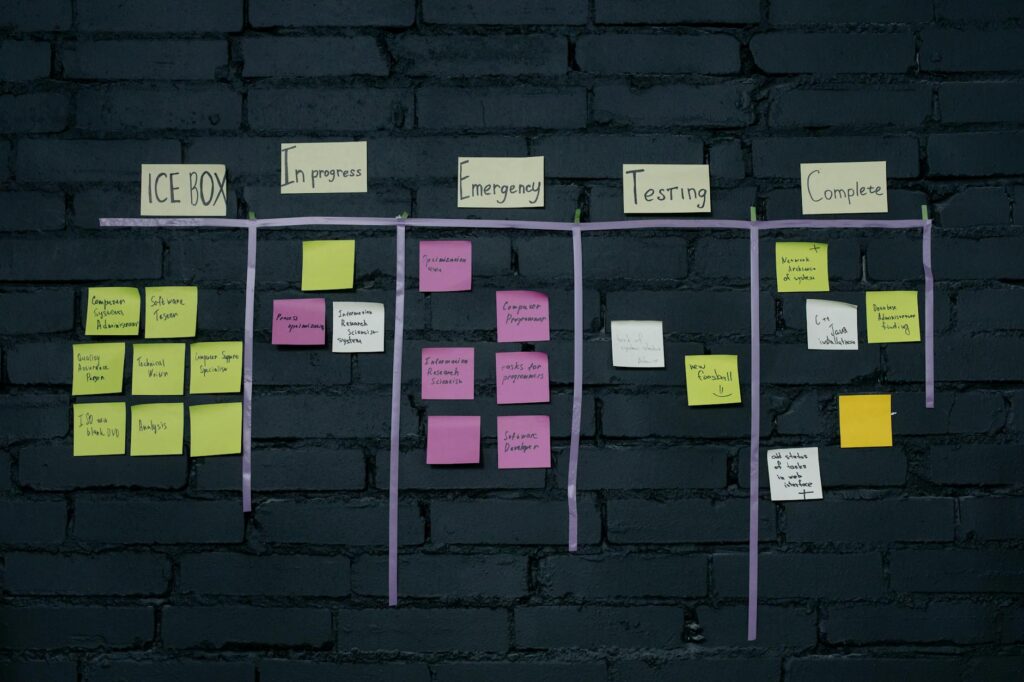What is kanban methods?

What is Kanban Methods?
Are you looking for a way to streamline your productivity and enhance your workflow? If so, kanban methods might be just the solution you need. This approach can help you manage tasks efficiently, reduce stress, and achieve your goals more effectively. Let’s dive deeper into the details of kanban methods and uncover how they can transform your productivity.
Understanding Kanban Methods
The kanban approach originated in manufacturing but has since evolved into a versatile system applicable in various fields, such as software development and even personal productivity.
Origins of Kanban
Kanban, which translates to “visual signal” in Japanese, began in the manufacturing sector, particularly within Toyota’s production system. In the late 1940s, Taiichi Ohno, a Toyota engineer, developed this method to improve production efficiency. He recognized the need to visualize workflow and inventory, allowing teams to manage work more effectively. By using simple cards to signal when more parts were needed, Toyota revolutionized its production processes, leading to reduced waste and increased efficiency.
Kanban in the Modern Context
Today, kanban methods go beyond manufacturing. Many organizations have adopted this approach for software development and personal productivity. For example, agile teams often use kanban boards to visualize project tasks and keep track of progress. This flexibility allows teams to adapt quickly to changing priorities and workloads. There’s a wealth of resources available for those wanting to learn more about kanban, including a comprehensive guide from Kanban University and insights from Atlassian.
Key Components of Kanban Methods
To implement kanban methods effectively, you need to understand its essential components. Let’s break them down.
Visual Management
At the heart of kanban lies visual management. This includes using kanban boards—a visual tool that displays tasks and their current status. Each task moves through various stages, from “To Do” to “In Progress” and finally to “Done.” This visual representation helps teams and individuals see their workload at a glance, making it easier to identify bottlenecks and prioritize tasks.

Photo by cottonbro studio
Work-in-Progress Limits
Another crucial element of kanban methods is the work-in-progress (WIP) limits. This concept focuses on limiting the number of tasks in progress at any given time. By setting these limits, you can enhance focus and reduce multitasking. When work is limited, it encourages individuals to complete tasks before starting new ones, ultimately leading to higher quality and efficiency.
Continuous Improvement
Continuous improvement is a principle embedded in kanban methodology. The goal here is to foster a culture where teams regularly reflect on their processes, identify areas for enhancement, and make adjustments. This iterative approach allows teams and individuals to evolve and adapt over time, ensuring that productivity remains high while minimizing waste.
Benefits of Implementing Kanban Methods
Many advantages come with adopting kanban methods in your daily life and projects.
Increased Productivity
One of the most significant benefits of kanban is increased productivity. By visualizing tasks and limiting work in progress, you can focus on completing tasks more efficiently. This means less time spent juggling multiple responsibilities and more time dedicated to what truly matters. Resources like Planview highlight how kanban can dramatically improve your efficiency.
Enhanced Work-Life Balance
Kanban methods can also promote a better work-life balance. By managing tasks effectively, you can reduce stress associated with overwhelming workloads. When your tasks are organized and visible, it becomes easier to allocate time for both work and personal activities. This balance is essential for maintaining overall well-being.
Flexibility and Adaptability
In today’s fast-paced world, being flexible is crucial. Kanban methods allow you to adapt to changing priorities and workloads seamlessly. Whether you’re managing a professional project or personal tasks, kanban provides the framework to adjust as needed without losing sight of your goals.
How to Get Started with Kanban Methods
Ready to implement kanban methods in your life? Here’s how to get started.
Create Your Kanban Board
Begin by creating your own kanban board. You can use physical sticky notes on a whiteboard or digital tools like Trello or Asana. Choose a layout that suits your needs and helps you visualize your tasks clearly.
Establishing Your Workflow
Once your kanban board is set up, it’s time to establish your workflow. Create columns that represent different stages of your tasks, such as “To Do,” “In Progress,” and “Done.” This structure will help you track the progress of your tasks and identify areas for improvement.
Iterate and Improve
Finally, it’s essential to regularly review and adapt your kanban system. Set aside time to reflect on what’s working and what isn’t. This iterative process ensures that your system remains effective and aligned with your goals.
Conclusion
Incorporating kanban methods into your workflow can significantly enhance your productivity and help you achieve personal goals. By visualizing tasks, limiting work in progress, and embracing continuous improvement, you’ll create a more organized, efficient, and fulfilling work-life balance. So why not give kanban a try and see how it can transform your approach to productivity?